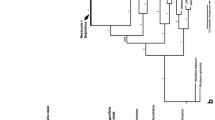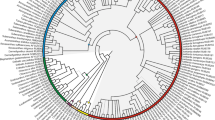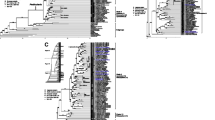Abstract
Lappula Moench includes ca. 70 species and exhibits a wide range of nutlet variation. Currently, the evolutionary relationships among species of Lappula have not been examined; therefore, to elucidate phylogenetic relationships and morphological evolution within Lappula and related genera, we conducted phylogenetic analyses with matrices that include 48 species as well as four DNA regions (ITS, trnL-trnF, rpS16 and psbA-trnH) and 18 morphological characters. These matrices were analyzed using maximum parsimony, maximum likelihood, and Bayesian inference methods. Analyses of the combined molecular and morphological data result in a phylogeny that is better resolved than that based solely on molecular sequence data. Phylogenetic results suggest that the current infrageneric classification of Lappula, at least at the subsectional and series level, is artificial. The evolutionary patterns of 18 morphological characters are investigated in a phylogenetic context. In Lappula, nutlet homomorphism and small corollas are resolved as ancestral, while nutlet heteromorphism and larger corollas are derived.




Similar content being viewed by others
References
Al-Shehbaz I (1991) The genera of Boraginaceae in the southeastern United States. J Arnold Arbor Suppl Ser 1:1–169
Baillon H (1888) Boraginacées. In: Baillon H. Hist. Pl. Librairie Hachette and Cie, Paris, pp 343–402
Bentham G, Hooker JD (1873) Genera Plantarum, vol 2. Lovell Reeve and Co, Williams and Norgate, London
Brand A (1931) Boraginaceae-Boraginoideae-Cryptantheae. In: Engler A. Das Pflanzenreich, vol 4. Leipzig, pp 236
Carr RL (1973) A taxonomic study in the genus Hackelia in western North America. Oregon State University
Chater AO (1972) Lappula. Gilib. In: Tutin TG, Heywood VH, Burges NA (eds) Flora Europaea, vol 3. Diapensiaceae to Myoporaceae. Cambridge University Press, London, pp 117–118
Chu GL, Kamelin R (1995) Nomenclatural notes on the Boraginaceae of China. Novon 5:17–18
Cronquist A, Holmgren AH, Holmgren NH, Reveal JL, Holmgren PK (1984) Intermountain flora: vascular plants of the intermountain west, USA vol 4. subclass Asteridae (except Asteraceae). New York Botanical Garden, New York
de Candolle A (1845) Prodromus Systematis naturalis regni vegetabilis, Paris
Doyle JJ, Doyle JL (1987) A rapid DNA isolation procedure for small quantities of fresh leaf tissue. Phytochem Bull 19:11–15
Felsenstein J (1985) Confidence limits on phylogenies: an approach using the bootstrap. Evolution 39:783–791
Fitch WM (1971) Toward defining the course of evolution: minimum change for a specific tree topology. Syst Zool 20:406–416
Frick B (1984) The biology of Canadian weeds: 62. Lappula squarrosa (Retz.) Dumort. Can J Plant Sci 64:375–386
Gilibert JE (1782) Flora Lituanica. Grodnae, pp 66
Gürke M (1897) Boraginaceae. In: Engler A, Prantl K. Die natürlichen Pflanzenfamilien Engelmann, vol 4. Leipzig, pp 71–131
Hasenstab KE (2009) Molecular phylogenetic systematics of the plant genus Cryptantha (Boraginaceae). San Diego State University
Higgins LC (1972) The Boraginaceae of Utah. Brigham Young University Science Bull. Biological series vol 16:54–60
Higgins LC (1979) Boraginaceae of the southwestern united states. West N Am Naturalist 39:293–350
Hillis DM, Bull JJ (1993) An empirical test of bootstrapping as a method for assessing confidence in phylogenetic analysis. Syst Bio 42:182–192
Huelsenbeck JP, Rannala B (2004) Frequentist properties of Bayesian posterior probabilities of phylogenetic trees under simple and complex substitution models. Syst Biol 53:904–913
Huelsenbeck JP, Ronquist F (2001) MRBAYES: Bayesian inference of phylogenetic trees. Bioinformatics 17:754–755
Hultén E (1971) The circumpolar plants. II. Dicotyledons. Almqvist and Wikselt, Stockholm, p 463
Johnston IM (1923) Studies in the Boraginaceae, I. Contributions from the Gray Herbarium, Harvard University, 68:43–80
Kang Y, Zhang ML, Chen ZD (2003) A preliminary phylogenetic study of the subgenus Pogonophace (Astragalus) in China based on ITS sequence data. Acta Bot Sin 45:140–145
Khoshsokhan M, Osaloo SK, Saadatmand S, Attar F (2010) Molecular phylogeny of Rochelia (Broaginaceae) based on nrDNA ITS and cpDNA trnL-F sequences. Iran J Bot 16:22–29
Långström E, Chase M (2002) Tribes of Boraginoideae (Boraginaceae) and placement of Antiphytum, Echiochilon, Ogastemma and Sericostoma: a phylogenetic analysis based on atpB plastid DNA sequence data. Plant Syst Evol 234:137–153
Lehmann JGC (1818) Plantae e familia Asperifoliarum nuciferae. Dümmler, Berlin, p 78
Lian YS, Wang JQ (1990) Eritrichium Schrad In: Kung XW, Wang WC. Flora Reipublicae Popularis Sinicae, vol. 62 (in Chinese). Science Press, Beijing, pp 116–150
Ma WB, Zhao XJ, Tan DY, Baskin CC, Baskin JM, Xue JH (2010) Nutlet dimorphism in individual flowers of two cold desert annual Lappula species (Boraginaceae): implications for escape by offspring in time and space. Plant Ecol 209:361–374
Maddison WP, Maddison DR (1992) MacClade, version 3.0: analysis of phylogeny and character evolution. Sunderland: Sinauer Associates
Mao ZM, Zhang DM (1994) The conspectus of ephemeral flora in northern Xinjiang (in Chinese with English abstract). Arid Zone Res 11:1–26
McEvoy PB (1984) Dormancy and dispersal in dimorphic achenes of tansy ragwort, Senecio jacobaea L. (Compositae). Oecologia 61:160–168
Mozaffar MK, Osaloo SK, Oskoueiyan R, Saffar KN, Amirahmadi A (2013) Tribe Eritrichieae (Boraginaceae s.str.) in West Asia: a molecualr phylogenetic perspective. Plant Syst Evol 299:197–208
Nasir YJ (1989) In Nasir YJ, Ali SI. Flora of Pakistan, vol 191, pp 137-149
Nazaire M, Hufford L (2012) A broad phylogenetic analysis of Boraginaceae: implications for the relationships of Mertensia. Syst Bot 37:758–783
Nelson A (1899) New Plants from Wyoming. VII. Bull Torrey Bot Club 26:236–250
Nelson A, MacBride JF (1916) Western plant studies. III. Bot Gaz 61:30–47
Ovchinnikova SV (2005) The system of the subtribe Echinosperminae (Boraginaceae) (in Russian with English abstract). Bot Zhurn 90:1153–1172
Ovchinnikova SV (2006) Ultrasculptural features of fruit surface in subtribe Echinosperminae (tribe Eritrichieae, Boraginaceae) (in Russian with English abstract). Bot Zhurn 91:105–116
Ovchinnikova SV (2009) On the position of the tribe Eritrichieae in the Boraginaceae system. Bot Serbica 33:141–146
Oxelman B, Lidén M, Berglund D (1997) Chloroplast rpS16 intron phylogeny of the tribe Sileneae (Caryophyllaceae). Plant Syst Evol 206:393–410
Popov MG (1953) Boraginaceae. In: Shishkin B K. Flora U.S.S.R. vol 19. Moskwa and Leningrad, pp 97–691
Posada D, Crandall KA (1998) Modeltest: testing the model of DNA substitution. Bioinformatics 14:817–818
Riedl H (1967) Lappula Gilib. in Rechinger KH. Flora Iranica, vol 48. Akademisch Druck u. Verlagsanstalt, Graz, pp 68–84
Riedl H (1997) Boraginaceae. In: Kalkman C, Noteboom HP, de Wilde WJ (eds) Flora Malesiana, Series 1, Spermatophyta Publications Department, Rijksherbarium, Leiden, pp 13:43–168
Sadat F (1989) Revision ausgewählter kritischer Gattungen der Boraginaceen aus der Flora Afghanistans. - Mitt. Bot. Staatssammlung München 28:1–210
Sang T, Crawford DJ, Stuessy TF (1997) Chloroplast DNA phylogeny, reticulate evolution, and biogeography of Paeonia (Paeoniaceae). Am J Bot 84:1120–1136
Stevens OA (1922) New records and other notes on North Dakota plants. Bull Torrey Bot Club 49:93–105
Sun YX, Zhang ML (2012) Molecular phylogeny of tribe Atraphaxideae (Poly-gonaceae) evidenced from five cpDNA genes. J Arid Land 4:180–190
Swofford DL (2002) PAUP*: phylogenetic analysis using parsimony (* and other method), version 4.0. Sunderland: Sinauer Associates
Taberlet P, Gielly L, Pautou G, Bouvet J (1991) Universal primers for amplification of three non-coding regions of chloroplast DNA. Plant Mol Biol 17:1105–1109
Takhtajan AL (1997) Diversity and classification of flowering plants. Columbia University Press, New York
Tate JA, Simpson BB (2003) Paraphyly of Tarasa (Malvaceae) and diverse origins of the polyploid species. Syst Bot 28:723–737
Thompson JD, Gibson TJ, Plewniak F, Jeanmougin F, Higgins DG (1997) The CLUSTAL_X windows interface: flexible strategies for multiple sequence alignment aided by quality analysis tools. Nucleic Acids Res 25:4876–4882
Venable DL (1985) The evolutionary ecology of seed heteromorphism. Am Nat 126:577–595
Wang CJ (1981) A study on the genus Lappula of China (in Chinese with English abstract). Bull Bot Res 1:77–100
Wang WT (1984) Notulae de Boraginaceis sinensibus (in Chinese with English abstract). Bull Bot Res 4:1–13
Wang QR (1990) Lappula V. Wolf. In: Kung XW, Wang WC. Flora Reipublicae Popularis Sinicae, vol 62. (in Chinese). Science Press, Beijing, pp 177–207
Wang ZJ, Pi XM (1997) New taxa of Lappula V. Wolf. From Xinjiang (in Chinese). J Xinjiang Univ 14:66–68
Weigend M, Gottschling M, Selvi F, Hilger HH (2010) Fossil and extant Western Hemisphere Boragineae, and the polyphyly of “Trigonotideae” Riedl (Boraginaceae: Boraginoideae). Syst Bot 35:409–419
White T, Bruns T, Lee S, Taylor J (1990) Amplification and direct sequencing of fungal ribosomal RNA genes for phylogenetics. In: Innis M, Gelfand D, Sninsky J, White T (eds) PCR protocols: A guide to methods and applications. Academic Press, San Diego, pp 315–322
Willson MF (1983) Plant reproductive ecology. Wiley, New York
Wu ZY, Wang H (1983) Plany geography (in Chinese). Science Press, Beijing, pp 62–63
Xue JJ, Zhang ML (2011) Monophyly and infrageneric variation of Corispermum L. (Chenopodiaceae), evidence from sequence data psbB-psbH, rbcL and ITS. J Arid Land 3:240–253
Zhu GL, Riedl H, Kamelin RV (1995) Boraginaceae. In: Wu ZY, Raven PH (eds) Flora of China, vol 16. Science Press, Beijing, pp 329–427
Acknowledgments
This research was funded by the CAS Important Direction for Knowledge Innovation Project (KZCX2-EW-305), and Xinjiang Institute of Ecology and Geography, Chinese Academy of Sciences. Thanks to Prof. AnRen LI (Institute of Botany, CAS, China) for his helpful identification to our field samples, to Dr. Stewart C. Sanderson (Shrub Sciences Laboratory, USDA, Utah, USA) for his offering of the American Lappula materials. Thanks specially to anonymous reviewers for their valuable and constructive suggestions.
Author information
Authors and Affiliations
Corresponding author
Rights and permissions
About this article
Cite this article
Huang, JF., Zhang, ML. & Cohen, J.I. Phylogenetic analysis of Lappula Moench (Boraginaceae) based on molecular and morphological data. Plant Syst Evol 299, 913–926 (2013). https://doi.org/10.1007/s00606-013-0772-3
Received:
Accepted:
Published:
Issue Date:
DOI: https://doi.org/10.1007/s00606-013-0772-3




